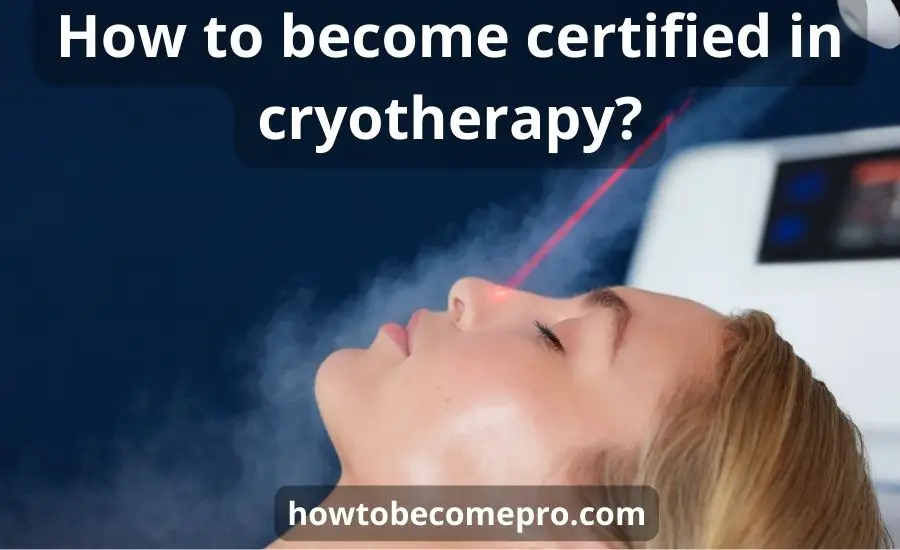If you’re interested in the potential advantages of cryotherapy and want to become certified in cryotherapy or a licensed expert in the subject, you might be asking how to get started and how to become certified in cryotherapy. Cryotherapy certification improves your knowledge and abilities while also boosting the confidence of patients looking for this specialist treatment.
A mix of education, online training, real-world experience, and keeping up with the most recent developments in the industry is required to become certified in cryotherapy. We’ll go over how to become certified in cryotherapy and its complete process step by step, giving you the ability to deliver safe and efficient cryotherapy treatments.
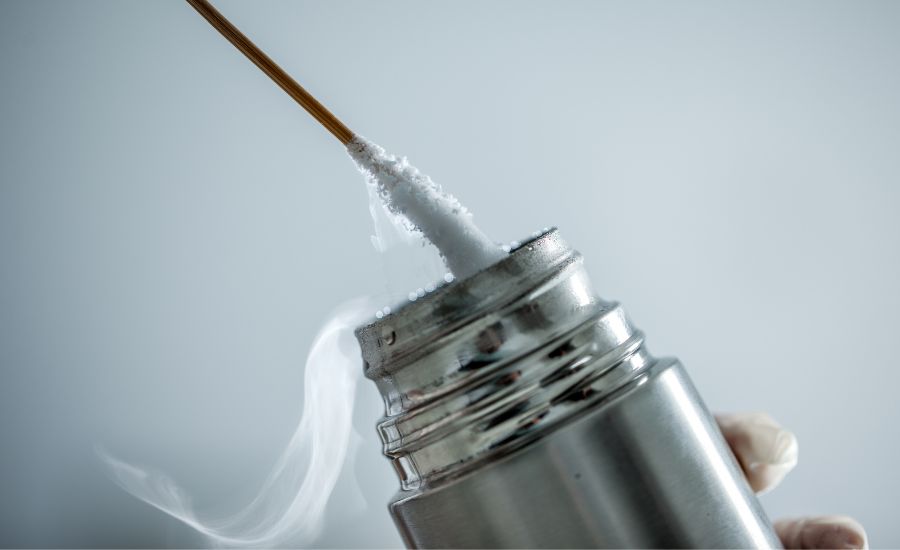
How to become certified in cryotherapy?
You can take the following actions to learn more about cryotherapy and how to become certified in cryotherapy.
Study the Basics
Start by learning the basics of what cryotherapy is and how it functions. Look for articles, books, or videos that detail the principles of cryotherapy’s science, as well as its advantages and drawbacks. You will have a solid base of knowledge thanks to this.
Seek Professional Training
It is advised to get a professional cryotherapy training course to become proficient in cryotherapy.
Look for training programs offered by respected institutions, wellness facilities, or cryotherapy equipment makers.
These courses typically address client management, safety procedures, the theoretical aspects of cryotherapy, and equipment operation.
Attend workshops and seminars
Keep a lookout for conferences, workshops, and seminars that focus on cryotherapy. These gatherings, which are frequently planned by business professionals, might offer insightful information on the most recent methods, studies, and developments in the industry. You may keep up with current events and increase your knowledge by attending such activities.
Gain Practical Experience
Practical experience is essential when learning about cryotherapy. If at all possible, look for an internship or an apprenticeship at a spa or cryotherapy facility. This will provide you the chance to watch and help skilled specialists in their work, comprehend the real-world implications of therapy, and learn how to use the equipment properly.
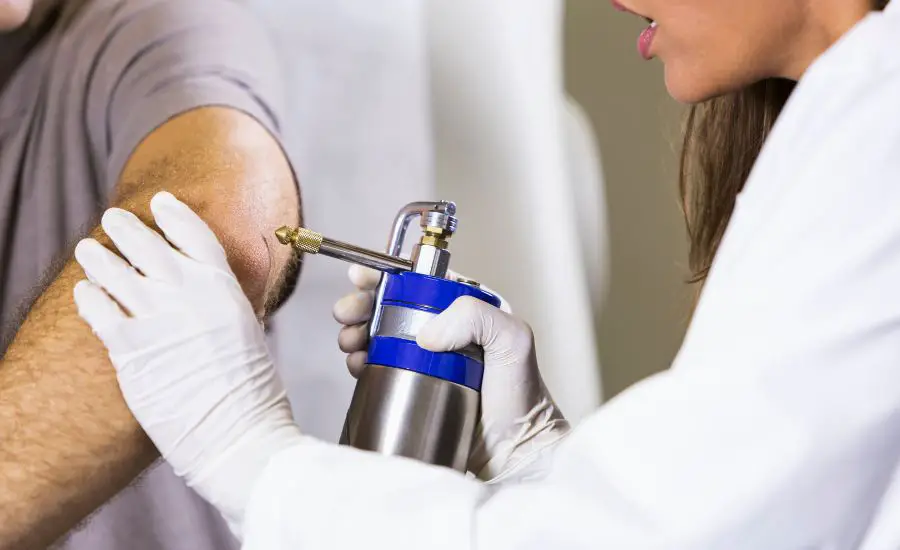
Network with professionals
Connect with professionals already employed in the cryotherapy training course sector by communicating with them. Participate in online training program communities and forums or attend industry events for connecting with professionals and hobbyists.
Making connections can open up doors for mentorship, give you access to useful resources, and open up work options for you.
Keep Up to Date
Because the field of cryotherapy research is continually changing, it’s critical to keep up with the newest developments in science, treatment methods, and safety regulations. Join industry organizations relevant to cryotherapy, follow credible websites, and sign up for industry publications. You can keep up with developments and maintain your knowledge by doing this.
Consider Certification program
Although it’s not always required, getting certified in cryotherapy can help establish your knowledge. Find a proper training course, online training course, or certification training program that addresses the theoretical information and practical abilities needed in the profession. Your professional profile could be improved, and it might improve your career prospects.
Make sure you select a cryotherapy certification program in cryotherapy that fits within your budget because they can be rather pricey. Think about the price of books, tuition, and other costs like travel and hotel.
This is how to become certified in cryotherapy. In addition, keep in mind that safety is crucial when receiving cryotherapy. Prioritize customer safety at all times, and follow all specified safety rules and procedures.
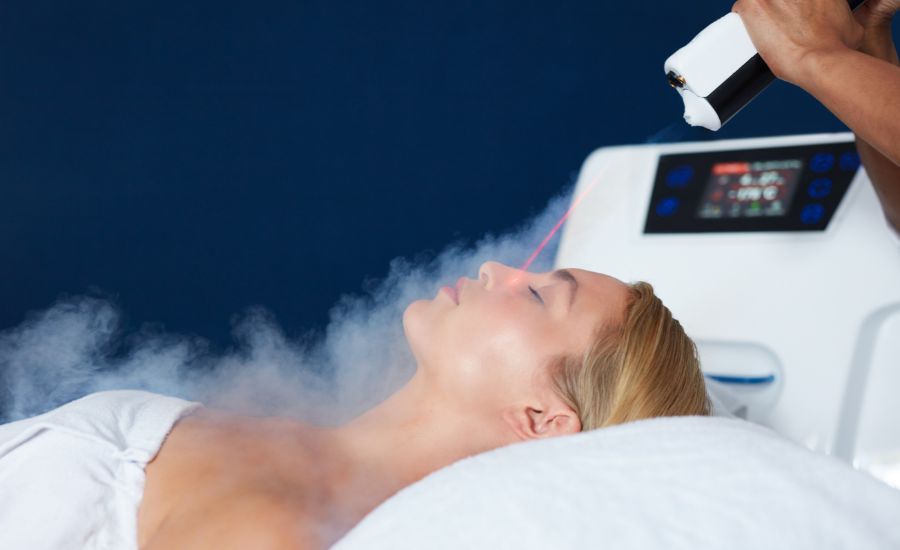
What does a cryotherapy technician do?
If you want to work as a professional cryotherapy technician, you need to have the necessary cryotherapy training and experience. Cryotherapy technicians use freezing temperatures and liquid nitrogen to help individuals heal and manage pain.
You will be in charge of running cryogenic chambers in cryotherapy services, which are specialized devices that can freeze the air inside a person’s body, as a cryotherapy technician.
Additionally, it will be your responsibility as a cryotherapy technician to make sure the chamber is correctly configured and working so that your client receives the greatest possible therapeutic results from the cold therapy that involves placing ice packs in the chamber.
You will also need to keep an eye on your patients during their sessions and ensure that they are safe and comfortable throughout the operation of cold therapy.
Cryotherapy technicians’ salary
By 2024, it is anticipated that the cryotherapy business containing good healthcare professionals would be worth $10 billion worldwide in a good cryotherapy location. Cryotherapy treatments are becoming more popular as people become more aware of their advantages. Equipment used in cryotherapy processes must be maintained and repaired by cryotherapy technicians.
A cryotherapy technician must know how to use the machinery safely and effectively. A cryotherapy technician or assigned Сryoniq technician often works 40 hours per week. Some businesses, however, provide flexible schedule alternatives.
Part-time employment is permitted by some employers while telecommuting options are provided by others.
The pay and benefits for cryotherapy technicians are above average. The majority of cryotherapy technicians claim to make between $30,000 and $50,000 a year. Some cryotherapy technicians earn as much as $60,000. Salary increases are depending on experience and level of education.
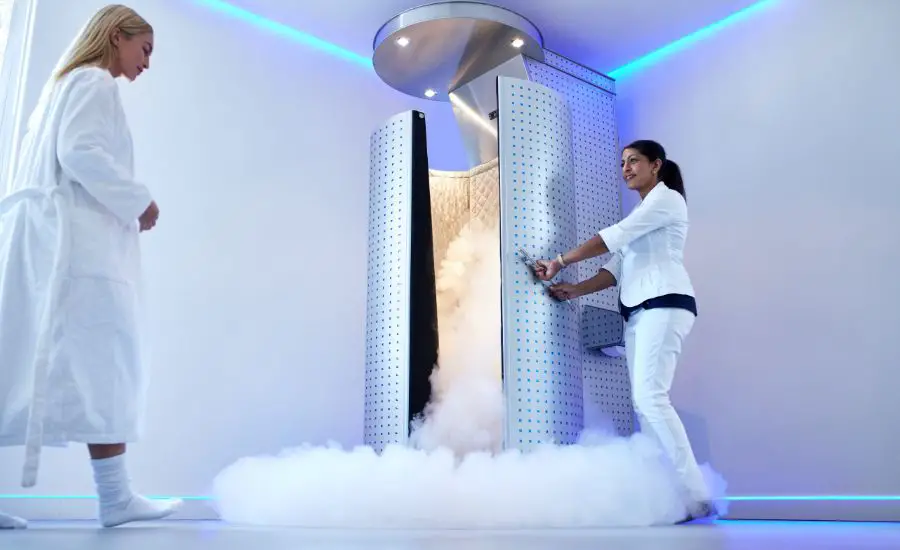
FAQ
What is cryotherapy?
A therapeutic procedure called cryotherapy involves various health benefits while briefly subjecting the body to extremely cold temperatures. The name “cryotherapy” is a combination of the Greek words “cryo,” which means “cold,” and “therapy,” which means “treatment.” Whole body cryotherapy program (WBC) is the most popular type of treatment.
During this procedure, a person enters a specific cryotherapy machine or booth where they are subjected to temperatures between -166°F and -256°F for a brief amount of time, usually 2 to 3 minutes. The intense cold from the extremely cold temperature of a cryotherapy session causes the body to go through several physiological processes.
It’s used to treat pain, treat skin conditions, and reduce inflammation by causing the blood arteries to contract, which reroutes blood flow to critical organs. The brain releases endorphins when the body is exposed to cold, which improves feelings of well-being and leads to pain relief.
When did cryotherapy begin?
Since the early BCs, there has been cold therapy. Around the year 1812, Napoleon’s soldiers employed this kind of treatment with the aid of icy cold streams.
Cryotherapy was first used to treat patients with multiple sclerosis and rheumatoid arthritis in Japan, where it was developed. Scientific research has been able to demonstrate that these treatments offer additional advantages. This treatment is crucial for both athletes and ordinary people because of its added advantages. Low temperatures are what give cryotherapy its value.
How to learn cryotherapy?
Learn the fundamentals of cryotherapy, look for professional training, and online course programs, get hands-on experience, go to workshops and seminars, connect with experts, remain current, and try to get a successful completion of a certification exam.
What degree is cryotherapy?
Usually, a degree program in cryotherapy is not evaluated on its own. Instead, it is a particular therapeutic approach or practice used in some industries, such as physical therapy, wellness, or sports medicine. You may want to think about taking cryotherapy training courses to become certified in cryotherapy:
• Medical Degree (MD or DO). Earning a medical degree enables you to become certified in cryotherapy and to focus on areas such as dermatology, sports medicine, or orthopedics, all of which may use cryotherapy as a therapeutic option.
• Physical Therapy Degree. A doctorate in physical therapy (DPT) permits you to work with patients who might benefit from cryotherapy as part of their rehabilitation or pain treatment.
• Sports science or exercise science Degree. A degree in sports science or exercise science provides a thorough grasp of human movement, physiology, and sports injury management. Cryotherapy as a recovery technique for athletes can be covered in these programs.
• Wellness or Alternative Medicine programs. Cryotherapy may be covered as part of the curriculum for some wellness or alternative health programs that some institutions and colleges offer as degrees or certificates.
Even though cryotherapy can be an effective strategy in some situations, it is frequently combined with other forms of treatment. As a result, the teaching focus might extend beyond simply cryotherapy.
How long is a cryotherapy session?
The type of cryotherapy being used and personal preferences are just two variables that might affect how long a session lasts. Here are some typical durations for various kinds of cryotherapy sessions:
• Whole Body Cryotherapy (WBC). During whole-body cryotherapy, a person enters a cryotherapy chamber or booth and is subjected to extremely cold temperatures across their entire body. A WBC session typically lasts 2 to 3 minutes. However, other people can begin with shorter sessions — roughly 1 to 2 minutes — and then gradually lengthen them as they get used to the cold.
• Localized cryotherapy. Applying cold temperatures to specific bodily parts, such as a joint or muscle region, is known as localized cryotherapy. Depending on the area being treated and the goal of the treatment, a localized cryotherapy session’s duration can change. It can last anywhere from a few seconds to about 10-15 minutes.
It’s crucial to remember that the precise length and quantity of sessions may depend on advice from a qualified expert or rules laid out by the cryotherapy facility. People should always take safety precautions and speak with a doctor before starting cryotherapy sessions, especially if they have any underlying medical issues.
How often should you do cryotherapy?
Cryotherapy session frequency can change depending on a patient’s needs, goals, and professional medical guidance. Here are some general recommendations for the number of cryotherapy sessions per week.
Whole Body Cryotherapy (WBC)
For the majority of people, it’s usual to start with two to three treatments per week. The frequency can be lowered to 1 to 2 sessions per week for maintenance after a few weeks. However, this may differ based on elements like the person’s health, level of fitness, and special objectives.
Localized Cryotherapy
The number of sessions needed to treat an illness will depend on its severity and nature. For a certain amount of time, some people might benefit from daily sessions, while others might find value from sessions a few times each week. To identify the right frequency for your unique needs, it is best to speak with a medical expert or cryotherapy specialist.
It’s crucial to pay attention to your body’s signals and track how cryotherapy treatments affect it. It’s best to lower the frequency or seek medical advice if you notice any negative side effects or pain. Cryotherapy treatments should not be utilized in place of medical care, and it’s important to heed any particular instructions given by a healthcare medical professional.
Conclusion
There are numerous measures on how to become certified in cryotherapy. You can take to accomplish your objective of becoming certified in cryotherapy. Start by looking for reliable certification courses that provide in-depth instruction in the cryotherapy industry.
The online training course covers the theoretical information, practical abilities, and safety procedures required for performing cryotherapy efficiently and safely. Once you’ve found a cryotherapy certification program that suits you, sign up and finish the necessary cryotherapy training course or coursework.
Cryotherapy can cure skin diseases like acne, psoriasis, rosacea, and eczema in addition to treating pain and lowering swelling.
Additionally advantageous are internships or apprenticeships in the global cryotherapy market where you can gain real-world experience. Last but not least, keep abreast of cryotherapy industry changes and maintain your cryotherapy certification in a cryotherapy training course through ongoing education or recertification procedures.
By taking these actions, you may improve your professional standing, learn more about the cryotherapy chamber, and give clients who are interested in this cutting-edge medical treatment excellent service. This is how to become certified in cryotherapy.
